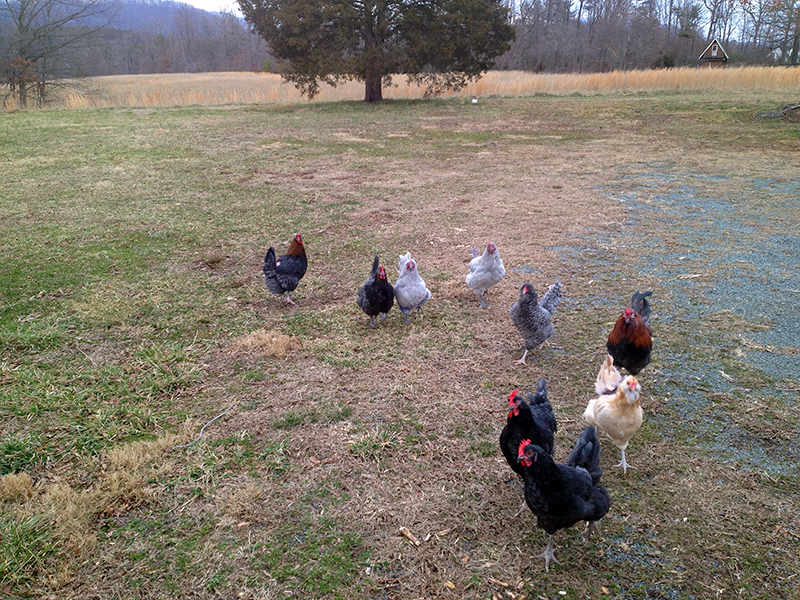March 23rd, 2014 §
For historical record it’s worth noting that last weekend I said goodbye to Griz, the rooster hatched last summer from a well-traveled egg. Griz had been up on CraigsList for months, for free, after he predictably began challenging his father, Calabrese, in bloody fights for control of the hens. I’d separated Griz on his own in a garage coop and left him to await his fate.
Here he is on the way to his new life. He turned out to have the Cuckoo Marans coloration of his olive egger mother but the green and gold feathers came from Calabrese, his Wheaten Ameraucana father.
It’s a funny thing that he got his name from my brother, who I gave naming honors because Griz’s egg spent time in my brother’s refrigerator before being recalled to Free Union to hatch. My brother chose Grizabella as the name for this chick, which when he turned out to be a cockerel I shortened to Griz. Just the other day I was reading some British magazines and learned that “grizzly” is a term used in that part of the world to describe a chicken of this black and white barred feather patterning—something I’d never heard in America. Weird coincidence, huh?
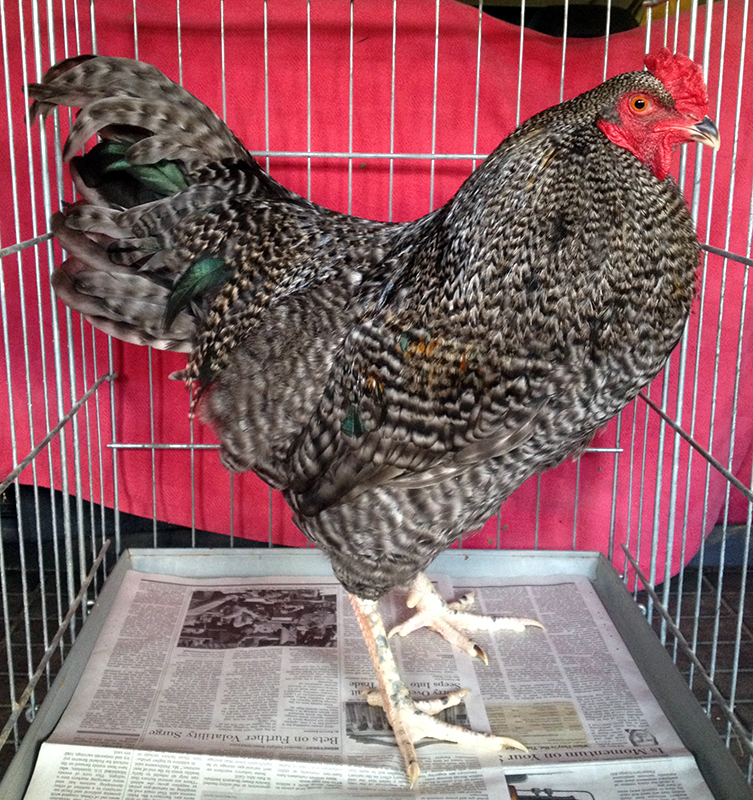
I am happy to report that Griz has gone on to a new family, who kept his name, and a flock of his own, along with a dozen of my hatching eggs. Part of the Bonafide flock will live on now in Madison, VA.
I got an e-mail from Griz’s new owner the other day:
Griz is doing well. He wasted no time on flowers when he met the ladies and they are all fast friends now. Thanks again.
I have to say I have met the nicest people in all my CriagsList chicken dealings. Maybe keeping chickens is particular to a certain personality type—who knows?—but I have always had positive experiences both buying and rehoming birds this way. It’s great to know a chick I hatched from an egg has found a good new life.
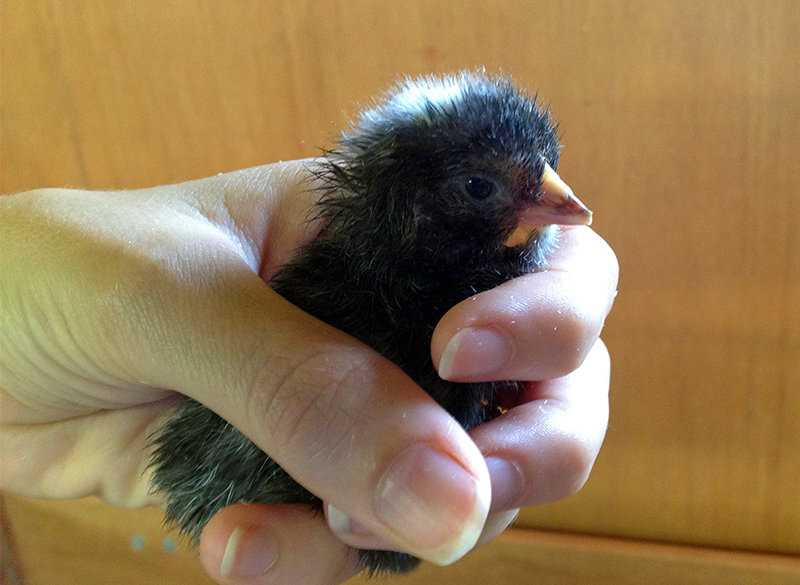
Just-hatched Griz, still damp, July 2013
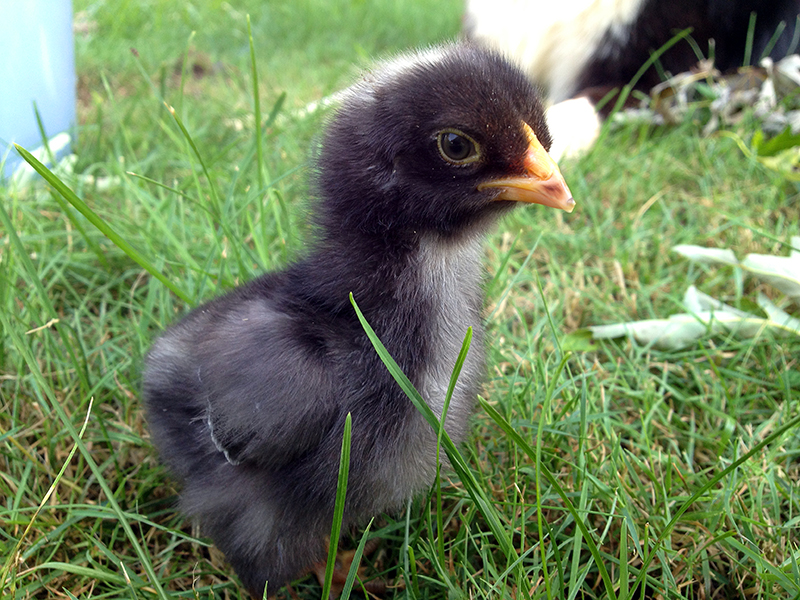
Griz at one week
January 20th, 2014 §
All that pottering in the garden yesterday was barely enough to keep me warm. To get the blood flowing I split some kindling, enough to get a few more wood stove fires going. I tore into a few rounds of of choke cherry cut this time last year when I cleared my wood line. It felt really good to split this beautiful red wood that I knew when it was still a living tree, festooned with honeysuckle and girded with wild brambles.
I was heavily supervised by the quality control team, which didn’t seem too perturbed when an errant piece of cherry clocked one of them in the head. That Griz (rooster, lower right) really keeps an eye on everything. He’s a personable rooster if I ever saw one—maybe because as an embryo he was rescued from a refrigerator and I held him in my hand within seconds of him kicking free of his eggshell?
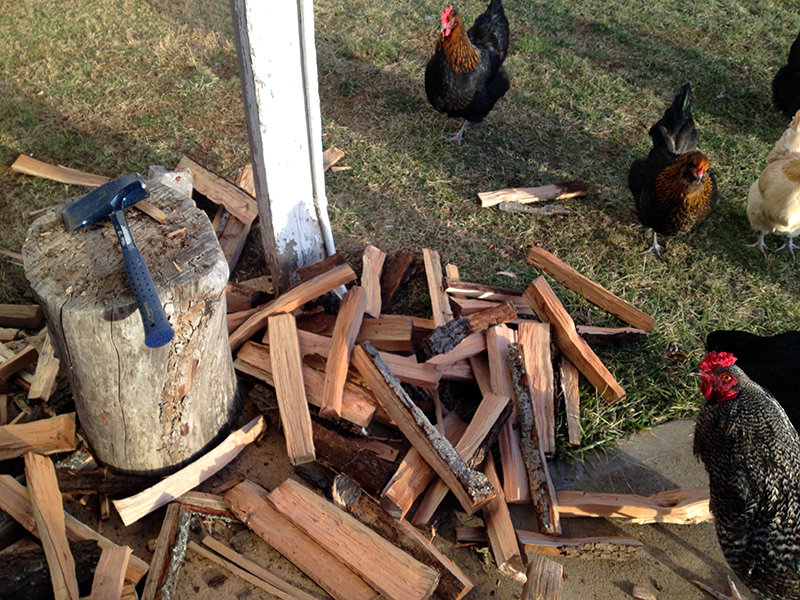
That makes me think of one of the most unexpectedly wonderful, and sometimes heartbreaking, aspects of this whole farm life. Whether it’s working to turn a living tree into fuel to heat my house or raising generations of homegrown chickens, it is beautiful to see cycles, and lifecycles, complete themselves under my watch.
I started stacking the kindling and this one, my English shadow, maneuvered himself right into portrait position and smiled for the camera with no direction from me. The Cora photobomb was similarly unscripted.
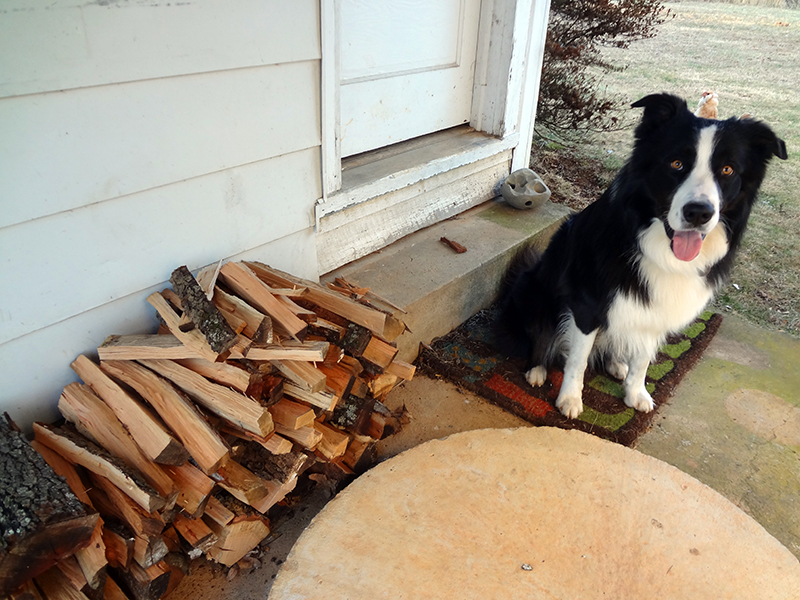
Speaking of Cora, she’s another country heard from with yesterday’s egg collection. Along with two small green eggs, and one large brown Dahlia egg, I found a pointy blue egg that could only have come from Cora. It’s one of less than ten that she’s ever laid in her life, which makes each of her eggs worth probably $100 when you figure in the cost of feed. If I hadn’t felt this little dear die and resurrect under my fingers, if I hadn’t become intimately acquainted with every muscle and vein of her skinless head as I fought to keep infection and fly infestation at bay, she would have long been Craigslisted by now.
But Cora still here, and once in a blue moon she lays a pointy turquoise egg. To my appreciation and great delight.
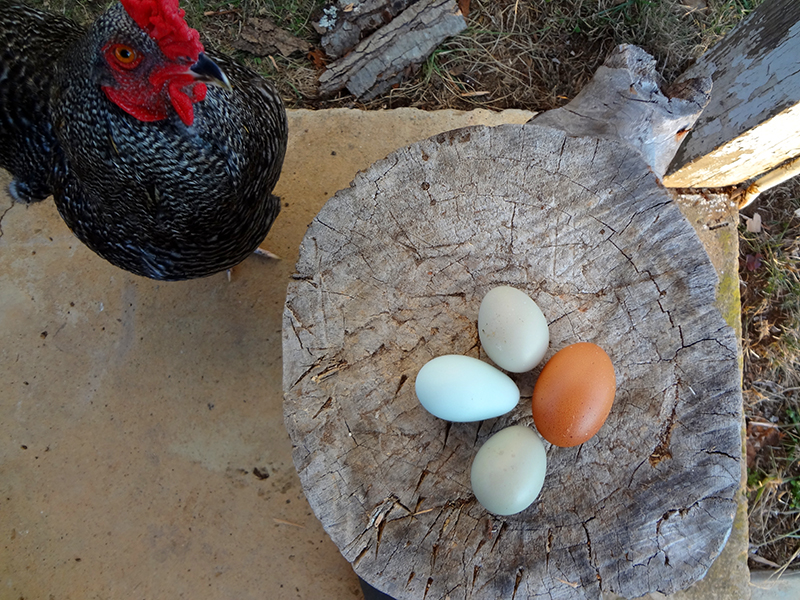
November 24th, 2013 §
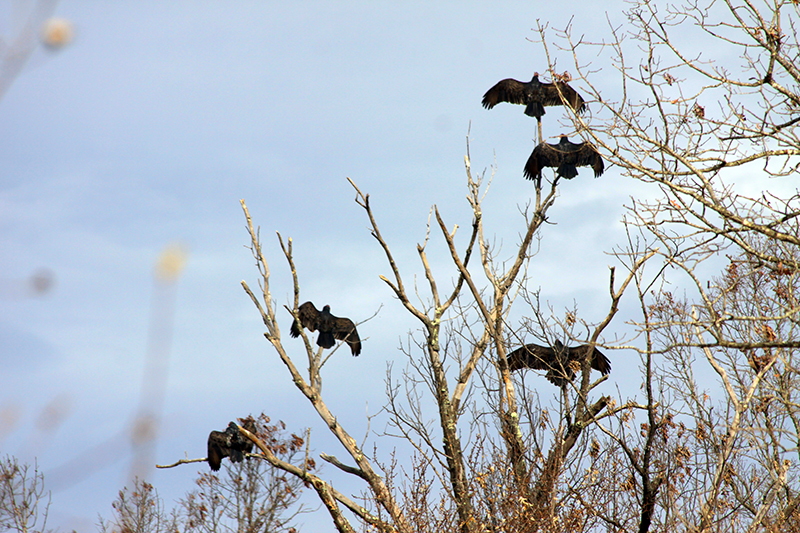
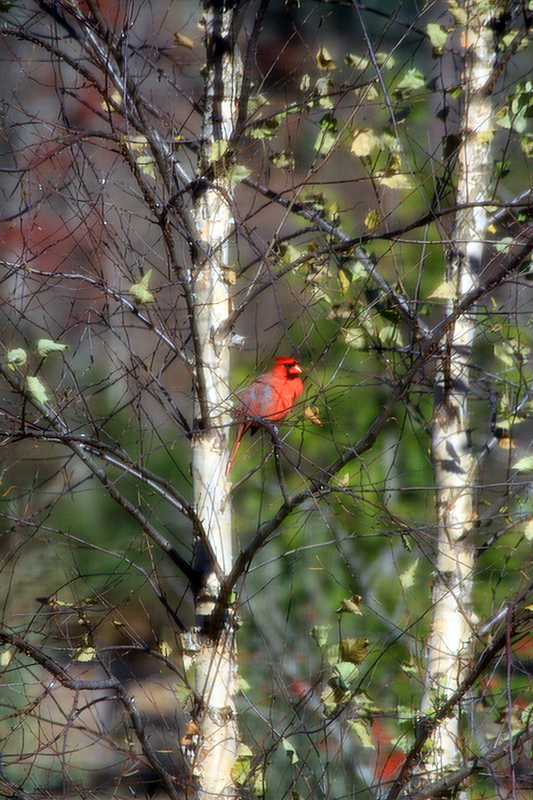
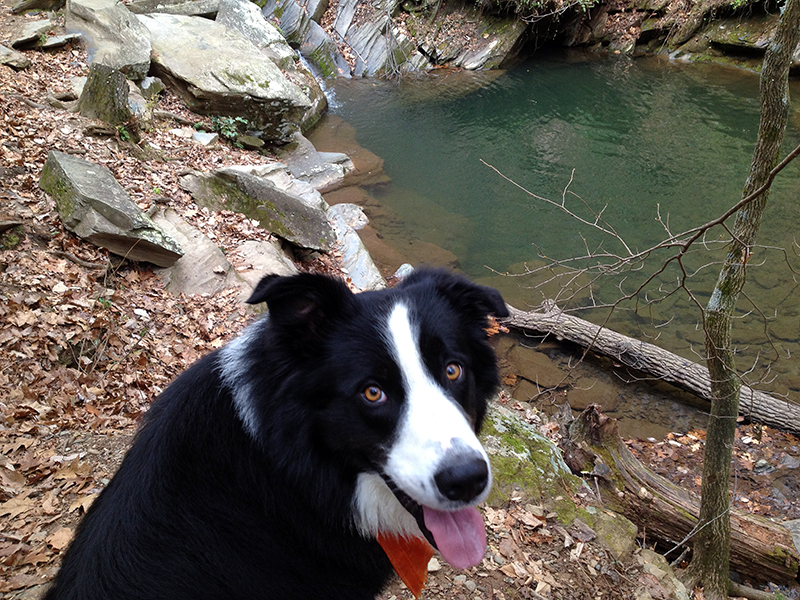
A friend and Tuck and I took a long hike up to Blue Hole and further up the mountain to Shenandoah National Park.
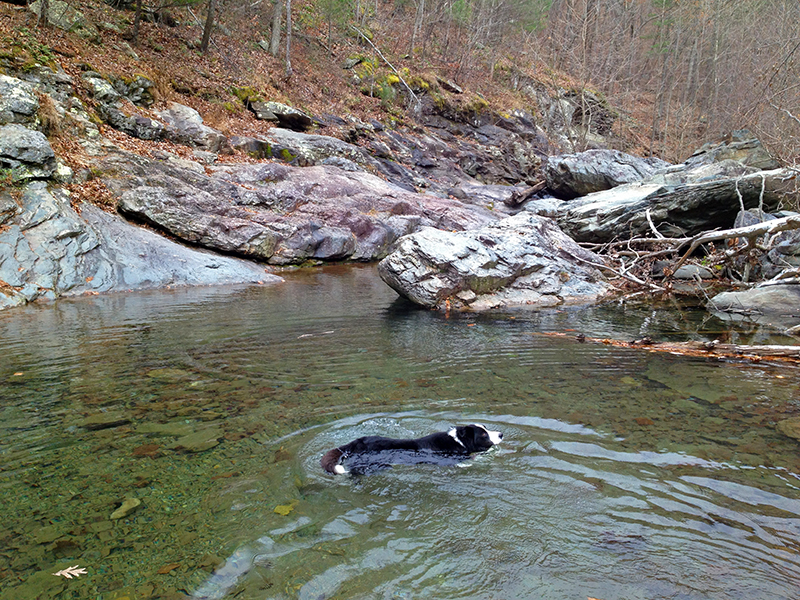
Tuck in one of the swimming holes along the North Fork of the Morman’s River. It hasn’t rained in a long time, and the water was low and crystal clear, the rivers easy to cross. This is the first and last time during the hike that Tuck got totally submerged. He figured out pretty fast that mountain streams in late November aren’t the same temperature as they are in summer!
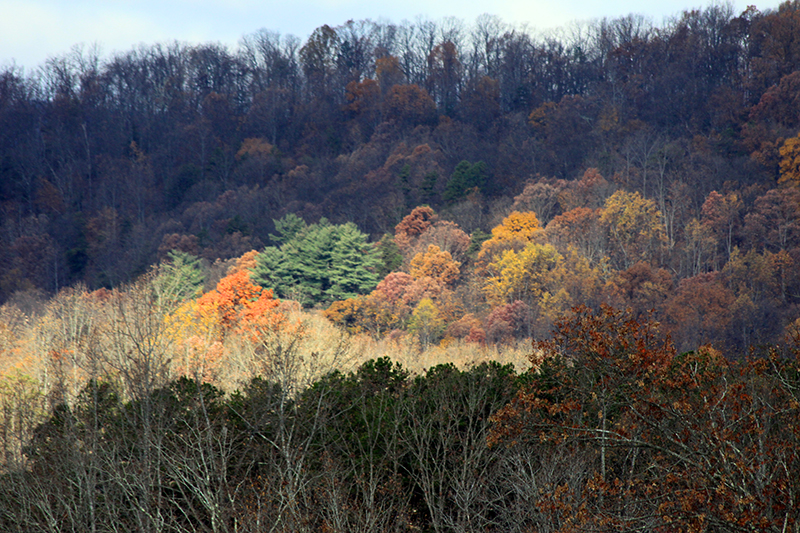
The last of the fall color. Just about all the leaves are down now, and it’s looking very wintery.

Blue Hole. This is where my friends and I did most of our swimming growing up. With the water snakes, timber rattlers, copperheads and ticks. Rural childhood. You can jump off those big rocks below and not hit the bottom of the hole.

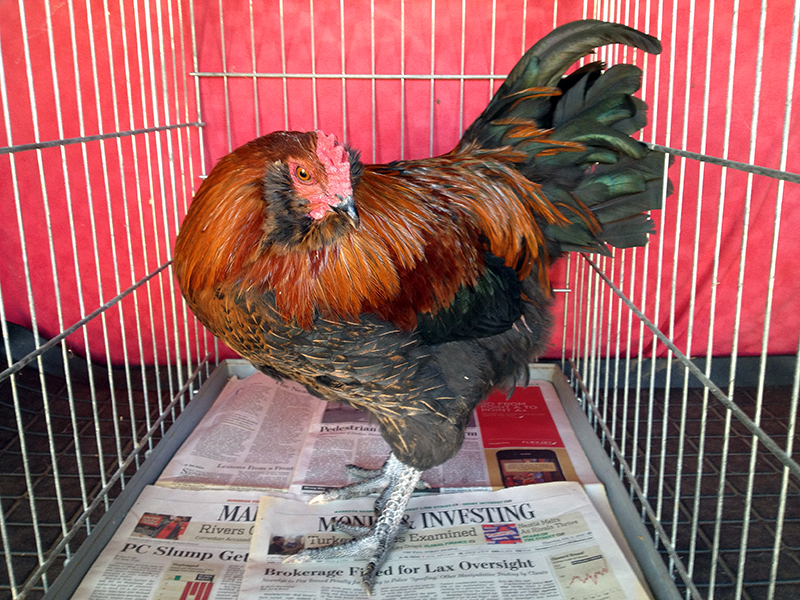
Yesterday I gave away one of the roosters that hatched this past summer. He’s turned into a handsome guy, but there’s no way I need three roosters in a small coop. This guy went home with a jolly lady and her young son—found via CraigsList—to rule over his own flock of hens. So he’s on to a better life, and I am happy about it. I knew he would be well-treated when his new owner asked what he prefers for treats! HA!
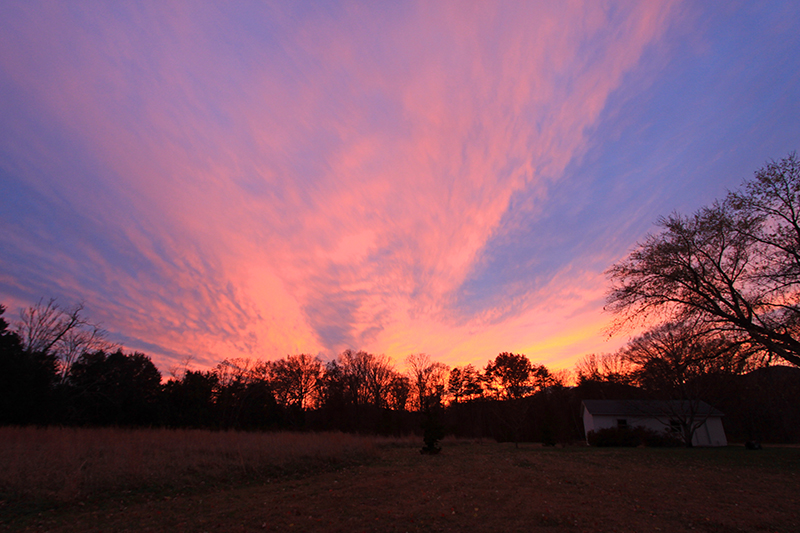
July 15th, 2013 §
On Saturday it was time to cull the deformed chick and move Oregano back in with the main flock. Two odious tasks I’d been dreading.
Before removing the two broody hens to their nursery coops, I had finally achieved a nice, stable and harmonious flock. The rooster was sweetly keeping order, and every bird was finally in good health, all wounds were healed and parasites eradicated. Things were going along well. However, whenever a chicken is added or subtracted from a flock, a power vacuum opens and each bird scrambles to attain the highest possible spot in the pecking order. The birds don’t “remember” a former flock mate, even if she was only out of the coop for a month. To all of them Oregano is a stranger, and their instinct is to kill her in order to preserve their own position in the flock.
So I know all this going in, thus the dread, and I tried a few things to see if I could smooth the transition. I put Oregano in the little run outside of the coop and released Calabrese, the rooster, from inside. I figured if he accepted Oregano back in to the flock he would perhaps help protect her from attack by the other hens, or they would see her as less of a threat if she had her baby-daddy on her side.
But when the two of them got together, this happened:
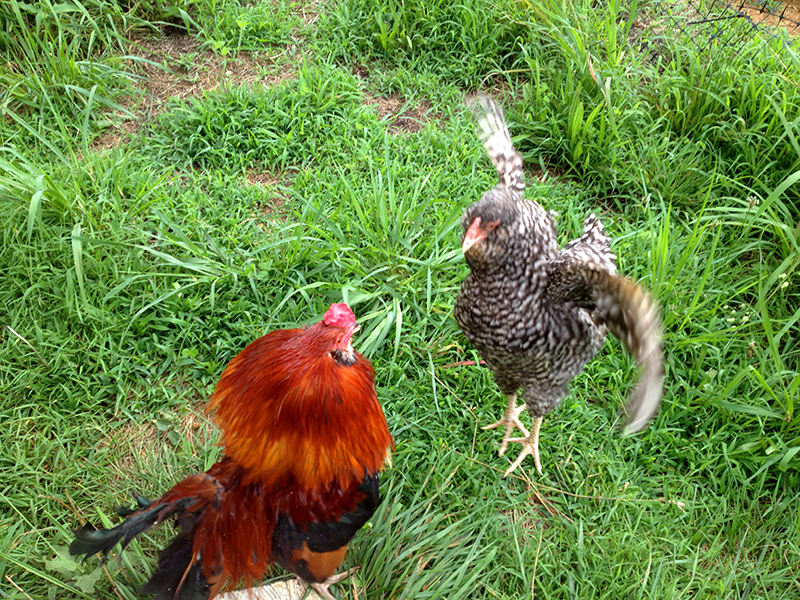
Then this:
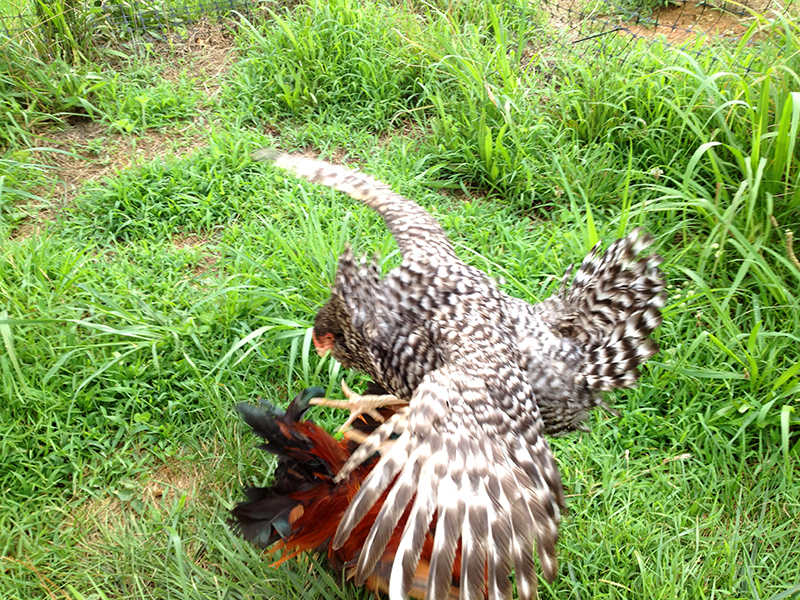
And this:
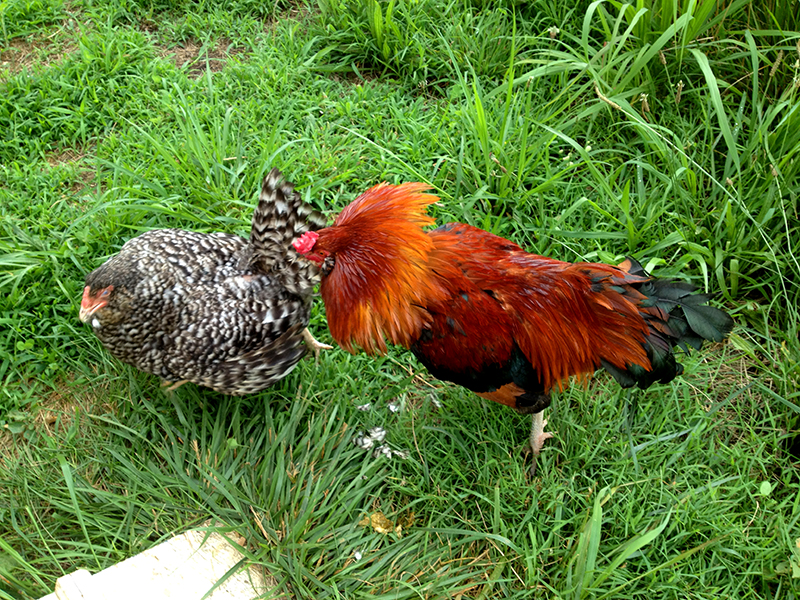
The birds went at each other in a dazzling display of spread feathers and clashing claws. Oregano puffed herself up as large as possible as she fended off Calabrese. Between attacks Calabrese “danced” for Oregano, so he was definitely conflicted about whether to fight or flirt with this “new” bird, with whom he had one biological offspring growing up in a nearby coop.
After things settled a bit I let the other hens out, one by one. Most hens ignored Oregano, and so I thought I was in the clear. So I released them all into the yard, hoping that some free ranging would give them something to occupy their thoughts and diffuse any potential conflicts. The flock ran out, and Oregano ran into the coop. She seemed grateful to be home again and started eating right away. Things seemed to be going okay.
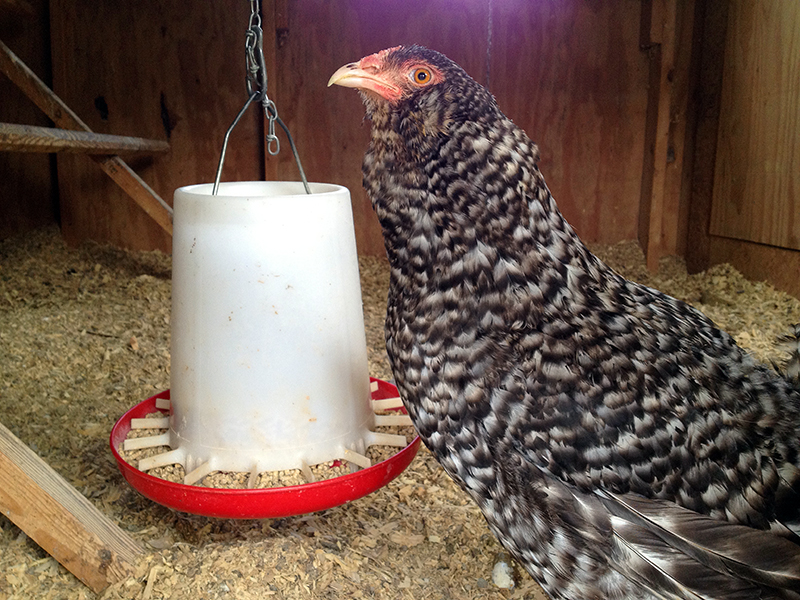
Then I went out in the evening and found the flock, minus Oregano, hanging out at the compost pile in the woods. Oregano was huddled under the fig by the garage, hiding. She had been shunned, and had to take shelter.
I called all the chickens back to the run behind the coop to force them to be together in a slightly smaller space. The hens took turns jabbing at Oregano’s head and she ran amongst them, head down and feathers fully puffed, looking like a football player lumbering down the field. It’s wasn’t peaceful but she seemed to be holding her own. And this was really her own battle to fight. There’s nothing I could do as they jousted.
Oregano spent the night sleeping in a nesting box—a good defensive position—with the other birds on the roosts. Sunday morning all seemed okay, but I had to go out of town for the day and was very nervous to leave the unstable flock cooped up all day. With no where to run, the confined area can be fatal (see Cora’s scalping and near-death experience last summer). But there wasn’t anything I could do as I had promised to go.
Last night I got home around seven and opened the coop immediately after parking the car. As I had feared, I found that Oregano had been attacked.
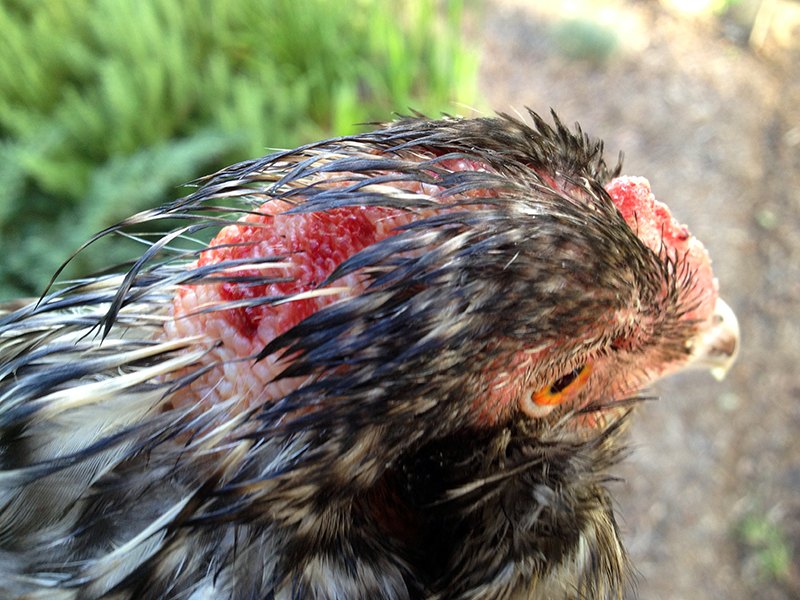
Her head and comb were torn open and bloody. So the first thing I did, before even letting my poor dog out to pee, was to grab Oregano and bring her inside for first aid. She didn’t even struggle.
Oregano got a Bactine cleansing, then a nice coat of Neosporin. I covered that with a thick layer of black salve, which supposedly tastes bad to attacking chickens. Over all that I sprayed Blu-Kote, a wound dressing. It masks the red blood color that encourages chickens to continue pecking. By the time she was done she looked a fright, but hopefully it would be enough to get her healed and keep the other birds off of her. The good news is that when I checked on the birds this afternoon Oregano didn’t seem to have suffered further injury, so hopefully her disguise is working.
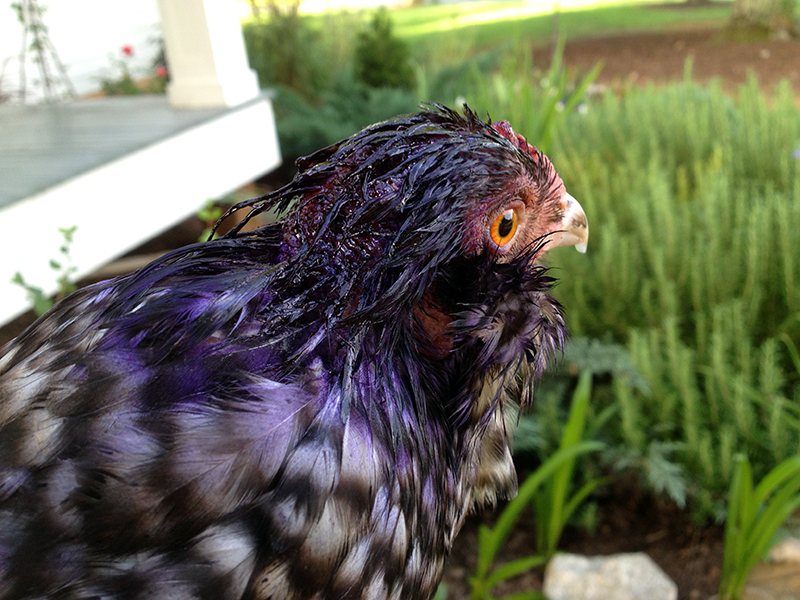
This poor girl. All she wanted to do was have a family. And after a month of sacrificing her own health, she lost her chick, was turned on by her former flockmates, and suffered injury at their beaks. I wanted to raise chicks with broody hens, because it’s less work for me, but I am not sure if the tumultuous flock dynamics makes it worth it. I still have Dahlia to get incorporated back into the flock, and the six babies. Better get a bigger tube of Neosporin…
June 21st, 2013 §
It’s the longest, lightest day of the year, and a lovely one at that. I spent the afternoon processing strawberries picked yesterday in Nelson County.
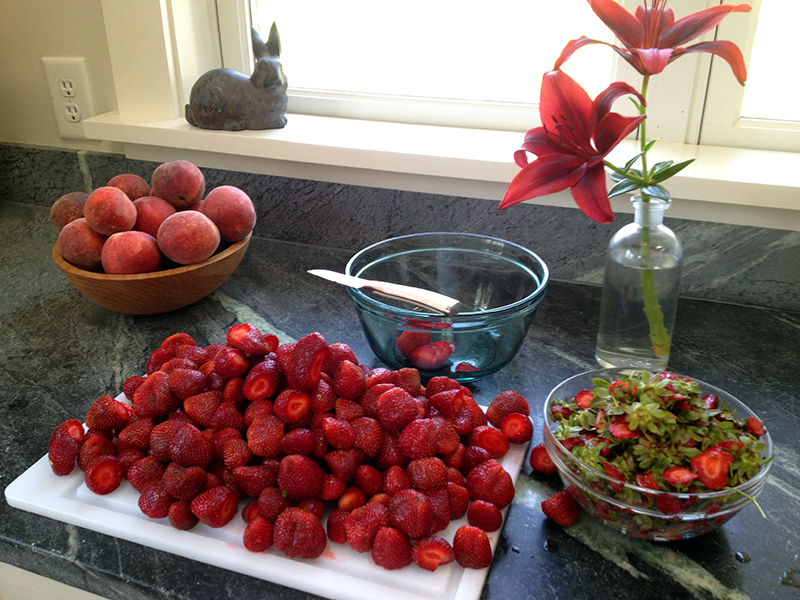
Summer fruits are the best, but you know what’s even better? Strawberry shortcake, baking in the oven right now. And the chickens definitely enjoyed the strawberry trimmings!
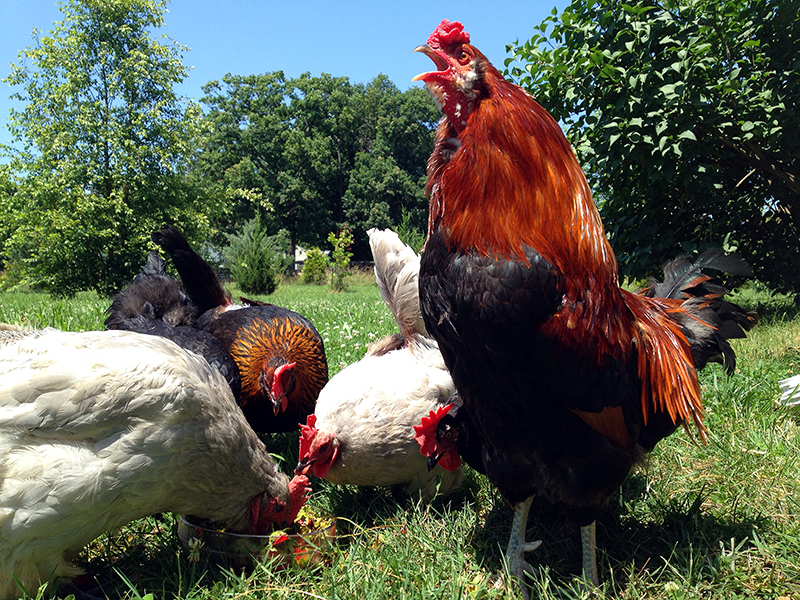
I’ve got a couple of growlers of Devil’s Backbone in the fridge and new friends on the way with fried chicken. We’re doing this Solstice up right with a good old-fashioned porch party on this beautiful evening.
Whatever you’re up to today, I hope you get a chance to celebrate the Solstice. And lest the sun hog all the astronomical attention, don’t forget to check out this weekend’s Supermoon!
June 17th, 2013 §
Ever since April I’ve been hoping one of my hens would go broody and hatch some chicks. Why? Because baby chicks are some of the things that make life worth living, of course. That and I am seriously curious to see what kind of crosses would result from my Wheaten Ameraucana rooster over Black Copper Marans, Lavender Orpingtons, a Barred Olive Egger, and whatever mix Lilac and Iris are (Black Australorps and Mottled Java, according to their breeder).* Iris and Lilac are in their second year of lay, and it’s good to have younger pullets coming along to take over egg-laying duties. And finally, now that I am free-ranging the birds outside most days, I anticipate that at some point I will have predator loss and don’t want to be caught out with not enough laying hens to keep eggs in the fridge.
A broody hen is a wonderful creature because she manages all the care, feeding, and warming of young chicks. If you have ever raised chicks, you know that it’s a big, messy job to monitor their brooder temperature, clean up after them, keep them safe from drafts and predators, and make sure they get enough to drink and eat. So I told myself that the only way I would raise chicks this year was if a hen did all the work for me!
Last year Iris went unbreakably broody and I ended up giving her a clutch of fertile guinea eggs. She brooded them in a dog crate in the garage and hatched out and raised nine guineas. Here’s one at several weeks old, posing for its CraigsList portrait:
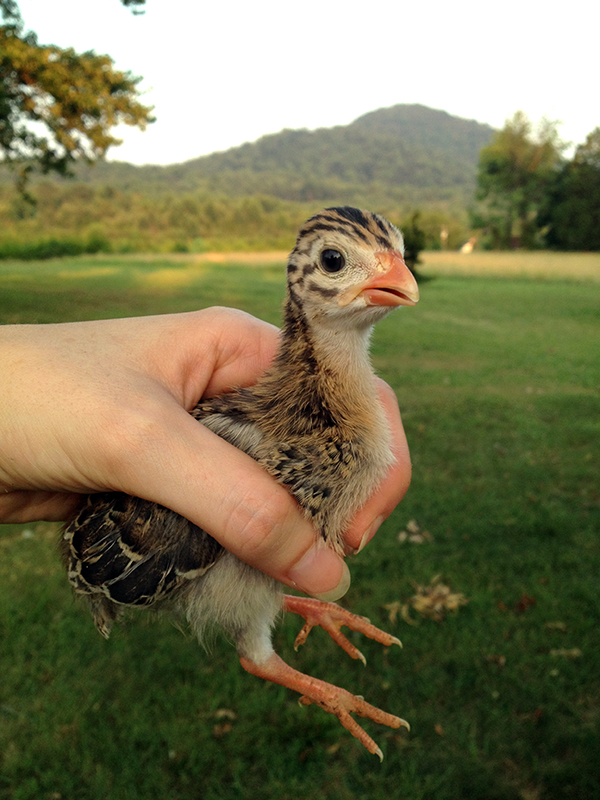
I got to watch the hatch and meet the still-damp keets, and it was one of the neatest days of my life. But this year, Iris has chosen to not do it again. Being trapped in a small cage with nine flighty, frantic, velociraptor-looking guinea keets was probably enough for her to sign off on motherhood forever. Not that I blame her—check out how those ravenous minidinosaurs are eying up their adopted mother’s toes while Iris pleads with her eyes for a Calgon moment.
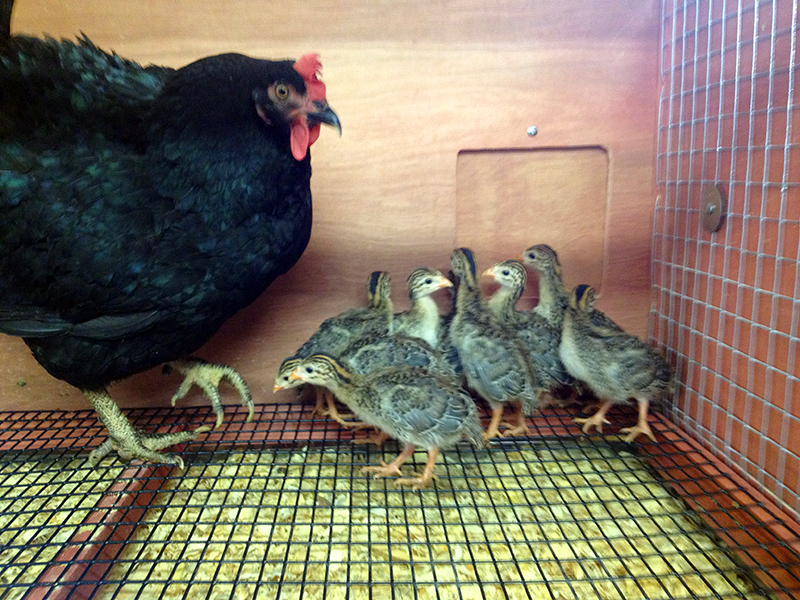
The most time-tested way to induce broodiness in a hen is to let eggs accumulate in the nest box. When the hen feels a growing clutch beneath her, some hormone switches in her brain that tells her to buckle down and brood. She will remain on the nest, barely eating and drinking, and will often pull feathers out of her breast so that she can keep the eggs tucked right next to her bare skin.
For weeks now I’ve been letting eggs accumulate, rotating out the older ones after a day or two in order to keep some in the fridge. I also placed the infamous glass eggs in the nests to trick the hens in to thinking there were always eggs waiting for a mother. And finally, it started to look like a few of then hens were beginning to feel broody.
Oregano, my beautiful barred olive egger, was the first to show any sort of devotion. After she’d been on the nest about a week, I fixed up a broody coop in the garage and built her a cardboard brood nest. It’s best to have a hen incubate eggs and raise chicks in a quiet, private place away from the bustle of the main coop, where flock mates may see new babies as tasty hors d’oeuvres. I was waiting for nightfall to move her to her new home when one of my Black Copper Marans saw the nest was exposed and jumped up to sit on the eggs.
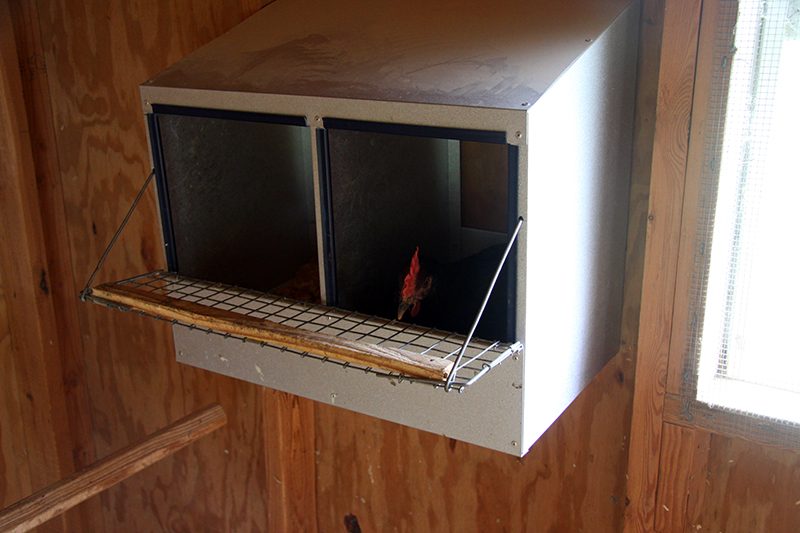
After dark, when I went to collect Oregano, the Black Copper Marans was still sitting tight on the eggs. One look and I got her message: She wanted a clutch of her own.
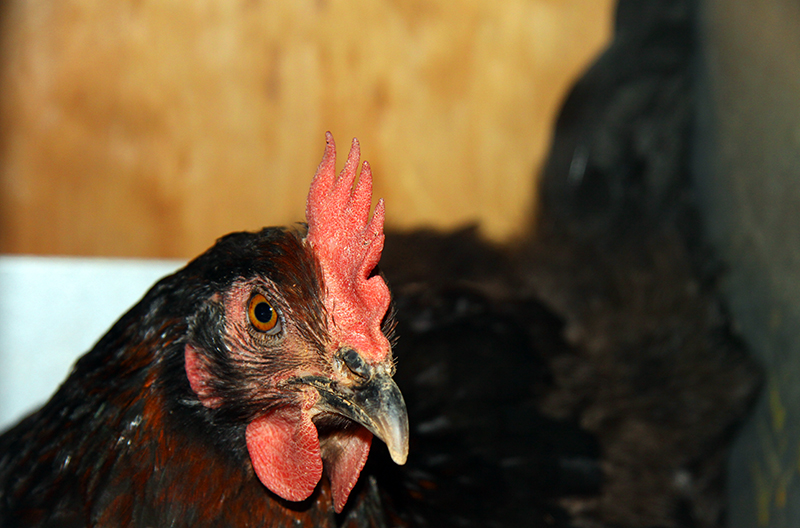
Oregano had assumed a broody position in the adjoining nest box. So I grabbed her and moved her and the eggs into the garage coop.
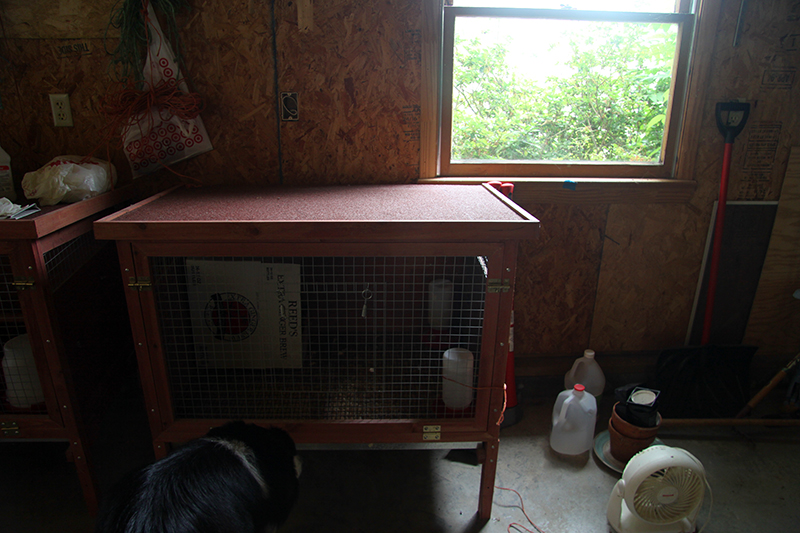
Oregano accepted her new nest and has stayed on it since Friday.
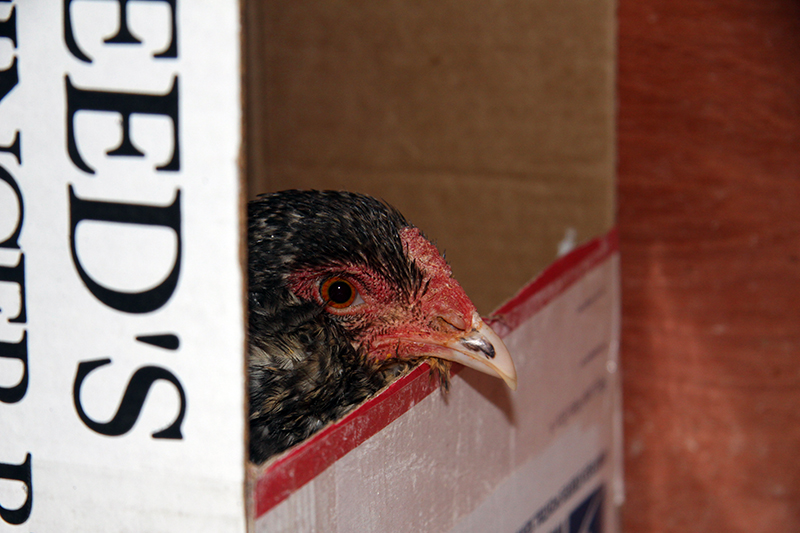
But the Black Copper Marans was still sitting on the glass eggs. And so I fixed up a second broody coop in the garage, built another cardboard next box, and last night moved her into a brood cage next to Oregano. So now I have two broody hens.
I have been saving out eggs for a week or so now, and when I get numbers I am satisfied with I will remove the glass and sacrificial eggs from under the hens and replace them with these fresh eggs. That way all embryos will start to develop at once, and all chicks will hatch at the same time. It’s a bit sad as the eggs are developing under Oregano, but their job really is to just “hold” the hen in a broody mindset until the more valuable eggs are introduced.
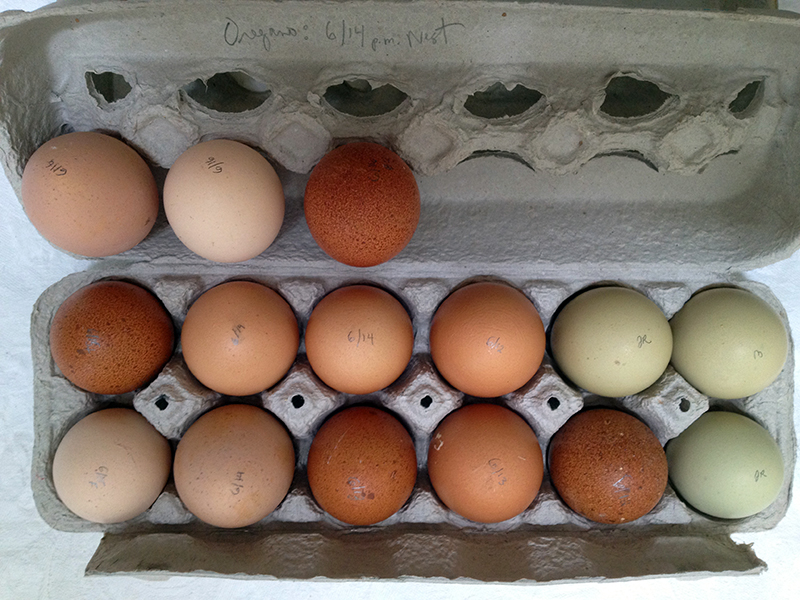
I wasn’t really planning on trying to raise two clutches, but at the end of the day it’s not such a bad thing. It means I can hatch more eggs, which is good as there is no way of knowing what the fertility rate is amongst my hens’ eggs. And, if one of the hens begins incubating and gives up, I could move the most valuable eggs to the other hen and have her take over. Thus, I am waiting until the same night to give both hens their eggs, and then we will see what happens! There is still a lot that can go wrong in the 21 days it takes to cook a chick, but I am having fun working with my broodies. If you’d like to know more, allow me to refer you to this excellent article by my favorite author on all things chicken, Harvey Ussery: Working with Broody Hens.
*A quick digression on chicken breeds and egg color: I have the right set-up to produce olive eggers, which, as their name suggests, lay olive colored eggs. To make a nice olive egger, you need a dark brown egg-laying breed (such as Black Copper Marans) mixed with a blue egg laying breed (Wheaten Ameraucana—my rooster). My Black Copper Marans don’t lay very dark eggs and I have no idea what sort of blue egg genetics my rooster carries, so I don’t suspect I will break any records with any pullets I hatch from that combination. But at the very least, I should end up with some sort of green egg, which is plenty exciting to me.
Now here is where it gets interesting. I have three eggs saved out from Oregano, my barred olive egger (the green eggs in the photo above). She does lay a very nice olive-colored egg, when she lays. By crossing her with Calabrese, and his blue egg genes, I may end up with a pullet that lays a really green egg, as opposed to an olive egg. But who knows, really? I have read about chicken genetics until I fell over from confusion and still am not sure what will happen. Mostly because I know nothing about the genetics of the birds I am starting with, other than their supposed breeds and what color eggs the hens lay now. And there’s always the possibility that I will hatch 100% cockerels and then the whole experiment is good for nothing but the freezer. And even if I do hatch pullets, it will be another year until they lay and who knows if I will even be in to chickens then!
February 5th, 2013 §
One upside of attending to my Lavender Orpington’s wound on Sunday was that I discovered she had lice. And when I snagged Oregano, my barred olive egger, for inspection I saw that she too had a few creepy crawlies. It was time for an intervention.
With a healthy flock, regular dust bathing will keep most parasites at bay. But in winter, with its frozen or muddy ground, the birds aren’t able to dust bathe as much as in the warmer seasons. This gives lice a chance to populate the birds. If unchecked, these blood-sucking parasites will deplete a bird to the point where it dies.
Thankfully my flock was no where near that stage. Yet, after spending a night researching various treatments I decided to go straight for the chemical intervention and not waste my time with more “natural” or “organic” methods. I really wanted to nip this infestation in the bud, particularly as it’s still winter and the birds need all the energy they produce just to keep warm and regrow the feathers they’ve lost. And, in another few weeks (if I can get Iris to go broody again) I’d like to try hatching some eggs, which means all my birds should be as healthy as possible and louse-free to avoid passing the bugs on to more-vulnerable chicks.
So I picked up a can of poultry dust, which is a permethrin-based formulation that you may have used for insects in your vegetable garden. I assembled my tools:
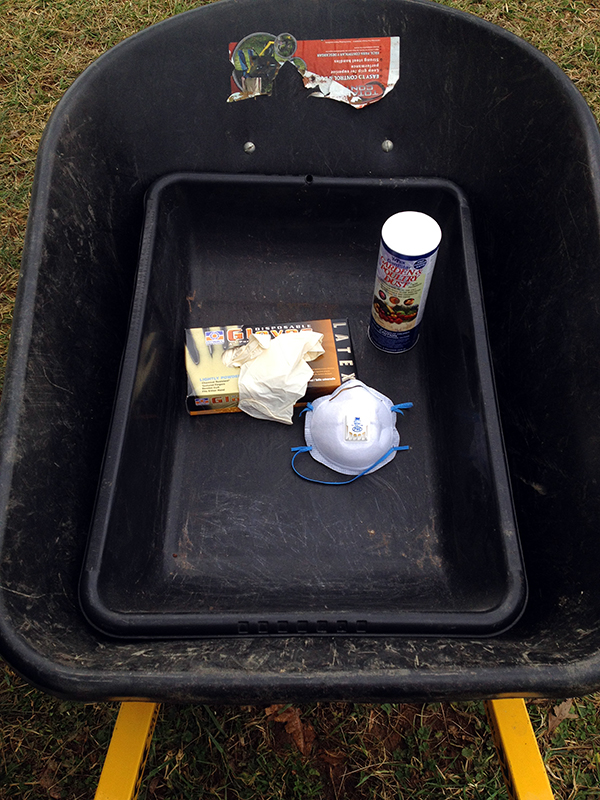
I also suited up in latex gloves and a dust mask. Well, the gloves were a joke because it took just one kick of a captured chicken to shred them. I went through five pairs through this process and still ended up covered in dust. If you’re concerned about skin contact, I’d suggest heavier gloves for this job. And, really, with all the flapping and wind I ended up covered with this dust so if you are truly concerned it may not be the treatment for you to use.
Cora, the Wheaten Ameraucana hen, was the first I caught in the coop. Following the advice of a YouTube video, I flipped her on her back. This seemed to calm her enough that I could powder under her wings, a favorite parasite hiding spot. I held her upside down to work the powder in to the feathers under her vent, which is where I saw the lice in all my birds.
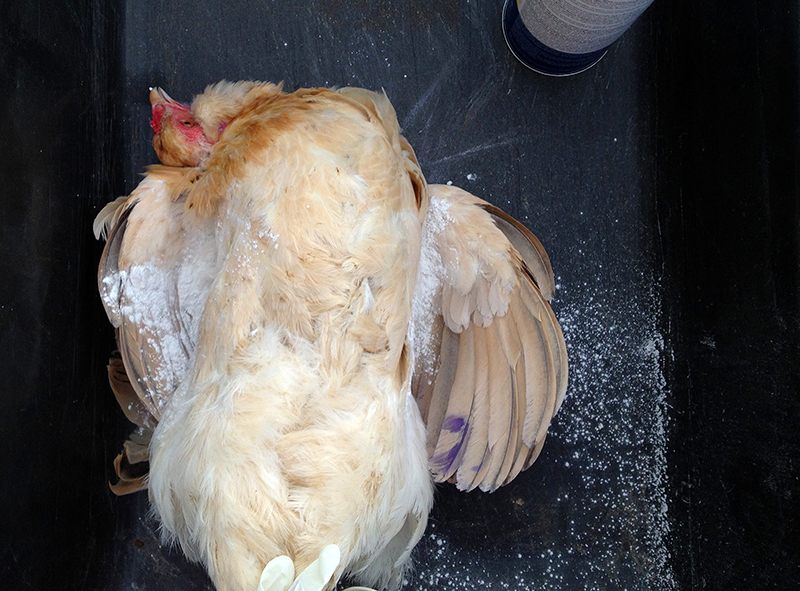
Lilac was up next.
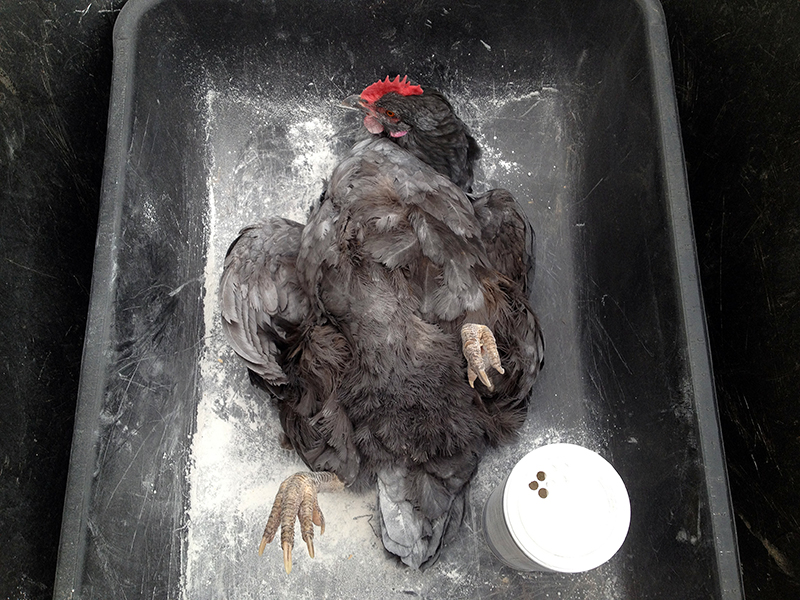
And so on through the flock. I left the injured Lavender until last so I could inspect her wound. It was open and bleeding, which I prefer to closed and infected, and seemed a tiny bit smaller than on Sunday.
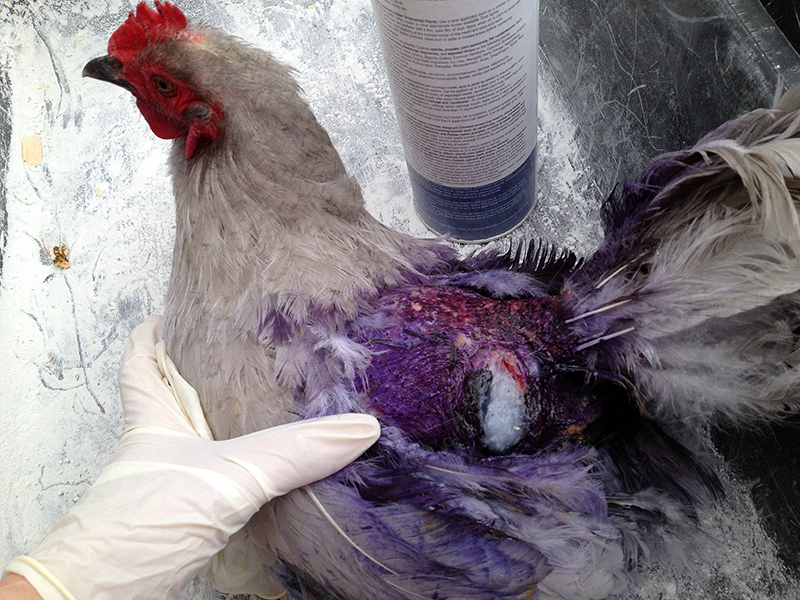
I packed it full of neosporin before dusting her.
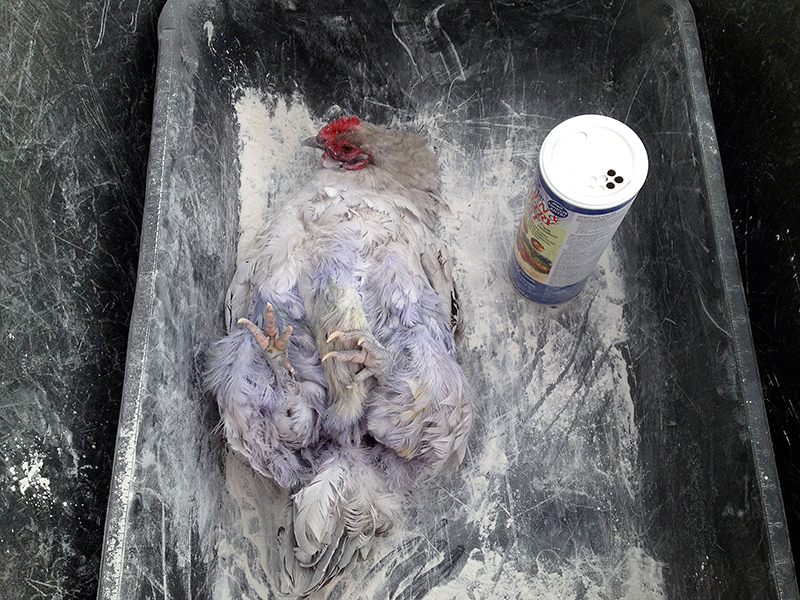
Now that’s a Lavender Orpington!
With the flock dusted, I did some housekeeping in the coop. I sprinkled food-grade diatomaceous earth in the nest boxes, in the chicken food, and filled a litter box with the stuff for dust-bathing in the coop. The diatomaceous earth, which is actually decomposed hard-shelled algae, acts in a mechanical manner (as opposed to chemical) on insects by slicing open their soft bodies, killing them.
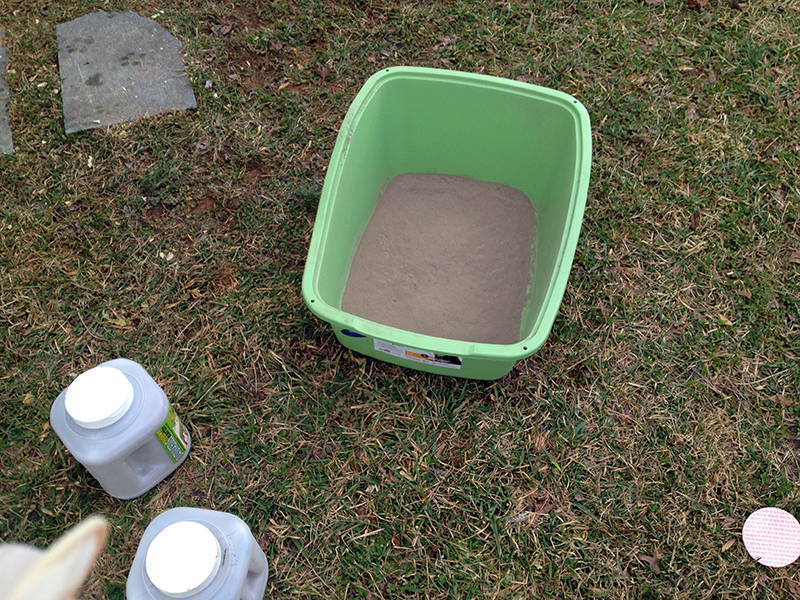
And with that the delousing procedure was complete. Now I get to look forward to ten days from now, when I repeat the powdering to kill any nits that will have hatched since today. Fun times!
